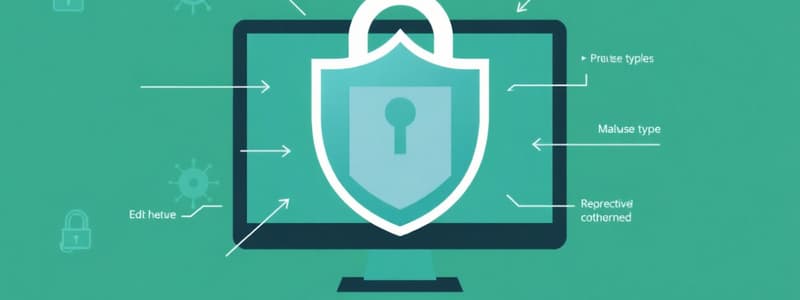Podcast
Questions and Answers
What characterizes a Trojan compared to a computer virus?
What characterizes a Trojan compared to a computer virus?
- Trojans can only infect systems through physical access.
- Trojans often disguise themselves as legitimate software. (correct)
- Trojans exclusively target mobile operating systems.
- Trojans replicate themselves to spread to other computers.
What is a common method by which a ransomware attack encrypts user data?
What is a common method by which a ransomware attack encrypts user data?
- By corrupting the operating system completely.
- By exploiting vulnerabilities in network security protocols.
- By executing software that encrypts files on various drives. (correct)
- By using a backdoor application to gain unauthorized access.
What does a keylogger spyware specifically aim to do?
What does a keylogger spyware specifically aim to do?
- Monitor network traffic for unusual activity.
- Record keystrokes to capture sensitive information. (correct)
- Override system security settings to access files.
- Generate fake warnings about viruses on the system.
How does malware often use the email address book during infection?
How does malware often use the email address book during infection?
What is one of the primary functions of worms in the context of computer viruses?
What is one of the primary functions of worms in the context of computer viruses?
What is the primary purpose of device hardening?
What is the primary purpose of device hardening?
Which of the following is a recommended practice for securing devices regarding passwords?
Which of the following is a recommended practice for securing devices regarding passwords?
How does regularly applying patches and updates contribute to device security?
How does regularly applying patches and updates contribute to device security?
What does disabling unused features on a device do?
What does disabling unused features on a device do?
Why is removing bloatware from new computers essential for device hardening?
Why is removing bloatware from new computers essential for device hardening?
What is a zero day exploit?
What is a zero day exploit?
Which of the following methods is NOT recommended to reduce the risk of malware infection?
Which of the following methods is NOT recommended to reduce the risk of malware infection?
Which scanning method is typically used when a user accesses a file?
Which scanning method is typically used when a user accesses a file?
What is the primary role of heuristic identification in antivirus software?
What is the primary role of heuristic identification in antivirus software?
What is the effect of real-time (on-access) scanning on computer performance?
What is the effect of real-time (on-access) scanning on computer performance?
What should be the first action taken in case of a malware infection that propagates over networks?
What should be the first action taken in case of a malware infection that propagates over networks?
Which of the following statements about security patches is true?
Which of the following statements about security patches is true?
What is the primary function of anti-virus software?
What is the primary function of anti-virus software?
Which type of settings should be configured carefully to avoid performance issues with antivirus scanning?
Which type of settings should be configured carefully to avoid performance issues with antivirus scanning?
Which of the following vendors is NOT associated with antivirus software?
Which of the following vendors is NOT associated with antivirus software?
Flashcards
Device Hardening
Device Hardening
A set of policies to improve the security of computers and network devices.
Anti-Virus/Anti-Malware
Anti-Virus/Anti-Malware
Software to detect and prevent malicious software (malware) from harming a computer.
Patching/Updates
Patching/Updates
Keeping software, drivers, and firmware updated to fix vulnerabilities.
Default Passwords
Default Passwords
Signup and view all the flashcards
Disabling Unused Features
Disabling Unused Features
Signup and view all the flashcards
Malware
Malware
Signup and view all the flashcards
Computer Viruses
Computer Viruses
Signup and view all the flashcards
Trojan Horse
Trojan Horse
Signup and view all the flashcards
Spyware
Spyware
Signup and view all the flashcards
Ransomware
Ransomware
Signup and view all the flashcards
Malware Infection Vector
Malware Infection Vector
Signup and view all the flashcards
Zero-Day Exploit
Zero-Day Exploit
Signup and view all the flashcards
Security Patch
Security Patch
Signup and view all the flashcards
Anti-virus Definitions
Anti-virus Definitions
Signup and view all the flashcards
Heuristic Identification
Heuristic Identification
Signup and view all the flashcards
On-access Scanning
On-access Scanning
Signup and view all the flashcards
Scheduled Scans
Scheduled Scans
Signup and view all the flashcards
Quarantine
Quarantine
Signup and view all the flashcards
Administrative Privileges
Administrative Privileges
Signup and view all the flashcards
Windows Defender
Windows Defender
Signup and view all the flashcards




